Приказ основних података о документу
Uticaj ideologije na arhitekturu Sokolskih domova u Kraljevini Jugoslaviji
Influence of ideology on the architecture of Sokol houses in the Kingdom of Yugoslavia
| dc.creator | Putnik, Vladana | |
| dc.date.accessioned | 2021-10-12T11:49:44Z | |
| dc.date.available | 2021-10-12T11:49:44Z | |
| dc.date.issued | 2013 | |
| dc.identifier.issn | 0352-6844 | |
| dc.identifier.uri | http://reff.f.bg.ac.rs/handle/123456789/1697 | |
| dc.description.abstract | Sokolski pokret je predstavljao veoma važan i jedinstven način borbe za ujedinjenje Južnih Slovena, pa je njegova uloga bila od izuzetnog značaja u konstruisanju jugoslovenskog identiteta u Kraljevini Srba, Hrvata i Slovenaca. Negovanje sporta kao simbola harmonije između tela, duše i duha je promovisalo fizičko vaspitanje kao put ka integralnom jugoslovenstvu. Cilj ovog rada je da se razmotre elementi ideologije i propagande koji su bili prisutni u estetici i vizuelnoj prezentaciji sokolske arhitekture. Kroz analizu sokolske životne filozofije može se zaključiti do koje mere je ona uticala na arhitekturu sokolskih domova. Veza između Sokolskog pokreta i jugoslovenske ideologije je implicirala detaljniji uvid u političke događaje koji su direktno uticali na proces gradnje i stilskog razvoja sokolskih domova. Ekspanzija podizanja sokolskih domova širom Kraljevine Jugoslavije se poklapala sa diktaturom kralja Aleksandra I Karađorđevića, što jasno ukazuje da je postojala snažna veza i podrška između Sokola i monarhije. Politička dimenzija Sokolskog pokreta je bez sumnje komunicirala sa konceptom integralnog jugoslovenstva. Promene koje su se desile 1934. godine, atentat na kralja Aleksandra, kao i određeni problemi sa Rimokatoličkom crkvom, rezultirali su osetnim smanjenjem podizanja sokolskih domova sve do 1941. godine. Kroz analizu političkog uticaja na arhitekturu sokolskih domova, kao i njihove estetike i ideologije, može se izvući zaključak o tadašnjim društvenim prilikama. Odatle sledi da se sokolska arhitektura može interpretirati kao primer političke umetnosti. | sr |
| dc.description.abstract | Sokol movement represented a very important and unique way of struggle for unification of Southern Slovenes; therefore its role in the constitution of Yugoslav identity in the Kingdom of Serbs, Croats and Slovenians was significant. Nourishing sport as a symbol of harmony between body, soul, and spirit de facto promoted physical training as the road towards true Yugoslavism. The main purpose of this paper is to consider elements of ideology and propaganda which were present in the aesthetics and visual presentation in the Sokol architecture. It can be concluded by analyzing principles of Sokol movement to what extent it influenced architecture of Sokol houses. The connection between Sokol movement and Yugoslav ideology suggests a closer look at the political events which directly influenced the process of building-up and stylistic development of Sokol houses. The building expansion of Sokol houses throughout the Kingdom of Yugoslavia matches the dictatorship of King Alexander Karadjordjević I, which clearly implies there has been a strong connection and support between the Sokols and the crown. The political dimension of Sokol movement has undoubtedly communicated with the concept of true Yugoslavism. Changes which have occurred in 1934, the assassination of King Alexander as well as problems with the Catholic Church considering the amount of influence Sokol movement had on Catholic members. This resulted in a major fall in building program of Sokols up until 1941. Through an analysis of political influence on architecture of Sokol houses, as well as aesthetics and ideology, a conclusion can be drawn about the social system of the time. Therefore, Sokol architecture can be interpreted as an example of political art. | en |
| dc.publisher | Matica srpska, Novi Sad | |
| dc.rights | openAccess | |
| dc.source | Zbornik Matice srpske za likovne umetnosti | |
| dc.subject | Yugoslavism | en |
| dc.subject | Yugoslavia | en |
| dc.subject | Sokol movement | en |
| dc.subject | ideology | en |
| dc.subject | architecture | en |
| dc.title | Uticaj ideologije na arhitekturu Sokolskih domova u Kraljevini Jugoslaviji | sr |
| dc.title | Influence of ideology on the architecture of Sokol houses in the Kingdom of Yugoslavia | en |
| dc.type | article | |
| dc.rights.license | ARR | |
| dc.citation.epage | 151 | |
| dc.citation.issue | 41 | |
| dc.citation.other | (41): 143-151 | |
| dc.citation.rank | M51 | |
| dc.citation.spage | 143 | |
| dc.identifier.fulltext | http://reff.f.bg.ac.rs/bitstream/id/587/1694.pdf | |
| dc.identifier.rcub | https://hdl.handle.net/21.15107/rcub_reff_1697 | |
| dc.type.version | publishedVersion |

